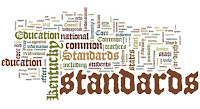Back in November, I worked with a group of fourth grade students on how to determine the main idea of a passage. We worked with a passage about forest fires that read as follows:
Some fire is a natural part of the life of a forest. Fire cleans out dead brush by burning it to ash. Then animals that live in the forest can find food more easily. New plants and trees have more room and sunlight to grow.
From Fires and Floods by Kate Waters, p 11
When students finished reading, I gave them the following question:
What is this passage mostly about?
A. How fires destroy forests
B. How fires can be helpful
C. How fires help animals
D. How fires clear away dead brush
The students collaborated and wrestled with each of the responses and then we gathered to sort out which response was the best one. After some debate and discussion, the class decided that the right answer was B.
Sitting off to the side, there was one little boy who wore a puzzled expression. He squinted his eyes, tilted his head, raised his hand and voiced his vehement objection, “Mrs. Yaris, there is no way that the answer can be B. This is about fire and I know that fire makes smoke and when smoke goes up into the sky, it makes holes in the ozone layer and that causes global warming. Global warming is bad. Fires aren’t helpful.”
Take a moment to digest this story. Think about what this child is doing as a reader and then think about what went wrong on his path to answering the question correctly.
As you do that, allow me to tell you one more story.
Last week, in my post titled The Reading Advantage, I wrote about the importance of reading volume and it sparked a lot of conversation in the twitterverse and among my local colleagues. As I chatted with classroom teachers about what gets in the way of allowing ample time for students to read, the conversation kept coming back to “the curriculum” and concerns about being in compliance with “the Common Core State Standards.” One teacher even shared that in “shifting curriculum and instruction to meet the new demands of the CCSS,” she felt like she was sacrificing what she “innately knew was good teaching and learning.” She felt like the Common Core didn’t allow room for creativity in teaching and certainly there would be no room for reading volume.
When she said this, it surprised me. My reading of the Common Core had led me to believe that reading volume was central to achieving the goals of this document but yet she planted enough doubt to force me to go back to look again. As I reread, I encountered line after line, paragraph after paragraph that spoke both directly and indirectly to this issue of reading volume:
From the College and Career Readiness Anchor Standards for Reading:
“Through extensive reading of stories, dramas, poems and myths…”
Appendix B, page 3:
“There is also evidence that current standards, curriculum, and instructional practices have not done enough to foster independent reading of complex texts so crucial for college and career readiness, particularly in the case of informational texts.”
The bottom of page 3 of Appendix A discusses the “general lack of reading” and goes on to attribute the “deterioration of overall reading ability” to “the problem of lack of reading.”
Also on page 4 of Appendix A:
“To grow, our students must read lots, and more specifically they must read lots of ‘complex’ texts—texts that offer them new language, new knowledge, and new modes of thought.”
Surely, if I looked hard enough, I could cite other examples but in going on this quest, I began to wonder if some educators are reading the CCSS in much the same way that my fourth grade student read the text about fire.
His response to the question about main idea was rooted in his background knowledge. While extensive and impressive, he wasn’t using what he knew to support what he was learning. His response was based on his reaction to the topic. And because of that, he got it all wrong.
In thinking about implementing the CCSS, we need to carefully consider the way in which we have read this document. Are our understandings of the Common Core based on what we know? Or, are they based on close, thorough readings of the text itself? If we allow our background knowledge to drive our understanding, like my fourth grader, we run the risk of getting it all wrong.

